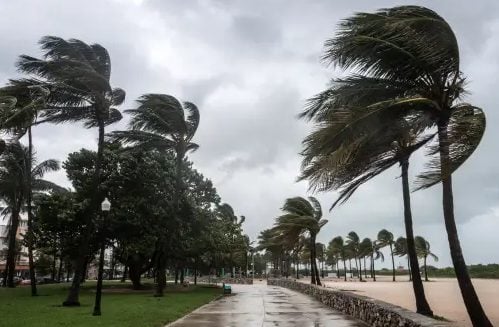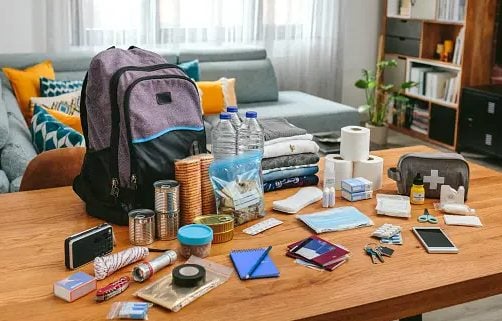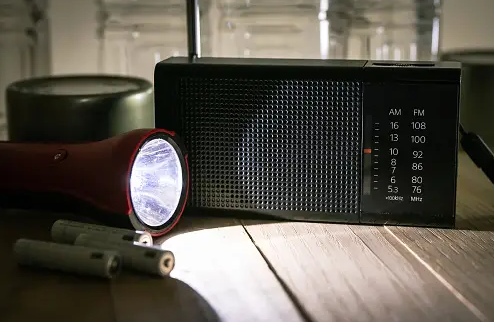BLOGS
Rainy Season Preparedness Guide: Emergency Kit For Typhoon
Last June, it was officially announced that the Philippines is under the rainy season. And this August, it is considered as the wettest month or the typhoon season. Typhoons, also known as hurricanes or cyclones in different parts of the world, are powerful and destructive storms that can cause significant damage to property, infrastructure, and pose serious threats to human life. Whether be it weak or strong typhoons, it is good to be prepared and well-informed before the disaster comes.
How well-equipped are you for the wet weather? Will you have access to enough food and supplies? Aside from the basic needs like a flashlight, canned goods, and medicines, there are still much more to prepare. We are here to help you prepare the important things from emergency kits to first aid kit, and survival kit to providing safety instructions. To know more about this guide, just keep on reading.
Why is there a need to have emergency kit and first aid kit during a typhoon?
During and after a typhoon, basic necessities like clean water, food, and shelter may become scarce or inaccessible. An emergency kit ensures that you and your family have the essentials needed to survive until help arrives or conditions improve. In the immediate aftermath of a typhoon, emergency services may be overwhelmed or unable to reach affected areas quickly. So having these kits allow you to be self-reliant and less dependent on external assistance.
It’s much easier to prepare an emergency kit in advance than to scramble for supplies at the last minute when a typhoon is approaching. Having a pre-packaged kit on hand saves time and reduces stress. Knowing that you have a well-prepared emergency kit for typhoon can provide peace of mind, both for you and your family. It’s one less thing to worry about during a stressful and potentially dangerous situation. In some cases, you may also be in a position to help neighbors or community members who are unprepared. Your emergency kit could include extra supplies that you can share with those in need.

Typhoon Preparedness Planning
When you hear the news about a typhoon entering the Philippine Area of Responsibility, these are the first few things you need to prepare with your family:
Before you lose all the connections, you must monitor weather forecasts and warnings from reputable sources such as the local meteorological agency or the PAGASA, Philippine Atmospheric, Geophysical and Astronomical Services Administration.
-
Formulate an emergency plan
Sticking together is important, this can be done by developing a family emergency plan that includes communication and evacuation plan. If authorities issue evacuation orders, follow them promptly. Know your evacuation routes and have a plan for transportation, including fuel and a map. You must establish a meeting point where you will assemble in case one family member is separated during the storm and share your emergency plan with them.
The first thing you need to reinforce are your doors and windows with storm shutters or plywood. Secure loose outdoor objects that can become projectiles in strong winds. You also need to trim tree branches and remove dead trees that may fall during the storm.
Securing your home also means securing important family documents. Store important documents like passports, birth certificates, insurance policies, bank account records, and medical records in a waterproof container or digital format. Make backup copies of digital documents and store them in a secure location.
Ensure your mobile phone is fully charged and have portable chargers or backup power sources available. Keep a battery-operated or hand-crank radio to receive updates in case of power outages.
Emergency Kit for Typhoon
In the Philippines, typhoons occur frequently enough that every residence should have a typhoon emergency kit on hand. Once the torrential rains begin, prepare for power disruptions, citywide evacuations, and other inconveniences.
The worst-case scenarios are avoidable with a typhoon emergency pack. It’s best to be aware of the materials to pack for a typhoon because it’s really impossible to predict whether the typhoon will hit your location hard or not.
9 Basic Essentials that an Emergency Kit should have
You can instantly assemble your survival bag but remember to periodically check and replace items in your emergency kit to ensure that they remain in good condition and that food and water supplies have not expired. Customize your kit to meet the specific needs of your family and location, especially if you live in an area prone to specific hazards like flooding or extreme cold. Here are the basic items you need to include:

-
Water
As many people say, you can survive for a long time as long as you have water. It keeps your body hydrated. The ideal amount is one gallon of water per person per day, you must be prepared for at least a three-day supply. Take note to have an extra amount of water because it could be needed for cooking and hygiene purposes.
-
Non-perishable food
For your survival pack, your consumables should be a two-week supply of non-perishable goods like Canned goods, dried fruits and nuts, protein or granola bars, cereal or crackers, and instant coffee or tea. These are easy-to-prepare items but will surely fill your stomach.
-
Eating materials
If you have prepared food, might as well prepare the supplies for eating. This includes paper cups, paper plates, plastic utensils, and portable container. You can also prepare plastic ties and garbage bags in your survival kit for the leftover food.
Flashlights
Following storms or calamities, power disruptions may last for several days. It is essential to have a flashlight on hand, preferably one that is battery or solar-powered, as it can be used to light up your surroundings even if all other options have failed.
-
Extra batteries
Spare batteries are essential to your survival kit. Your battery-powered radio and flashlights might lose its battery life sooner if you keep using it, so extra batteries are the key.
-
Warming materials
During the cold weather after the typhoon especially when flood arises or a roof went off, shelter and warming are needer. You could make use of a plastic sheeting, tarpaulin, warm blanket, or any clothing like hats and gloves.
-
Infant needs
When you have an infant, one of the first things you need to include in your emergency kit for typhoon are the baby essentials. You should not forget to pack a good number of diapers, infant formula, wipes or toilet paper, and some kid’s entertainment like a book or a toy.
And if you are a furparent, don’t forget to bring their essentials too like food, water, and any necessary medications for pets.
-
Personal hygiene items
- Toilet paper
- Hand sanitizer
- Soap and hand towels
- Feminine hygiene products
- Toothbrush and toothpaste

-
Other supply kit
In your survival bag, bring some tools or a multi-tool that could be useful for various tasks and repairs. You will also need to bring your first aid kit and medical supplies including the basic medicines, and special medications. Your first aid kit should include these:
- Adhesive bandages.
- Sterile gauze and bandage rolls.
- Antiseptic wipes.
- Tweezers and scissors.
- Pain relievers.
- Prescription medications (if needed).
- First-aid manual.
Have a Worry-Free and Secured Home during the Typhoon Season
Deep flooding is the main concern of the majority of Filipinos during the rainy season, thus it is one of the most important aspects that buyers of houses and lots in the Philippines take into account. While we can never overcome the forces of the environment, we can always adapt by preparing a typhoon emergency kit.
Give your loved ones the security they need during this rainy season by buying a luxurious, safe, and beautiful property in Brittany!
Suggested Read: Health Emergency Response: What You Need To Know
Suggested Read: Top 10 Best Car Battery Brands in the Philippines
Suggested Read: Essential Items Everyone Should Have At Home
Suggested Read: Must-Have Items For 2022















